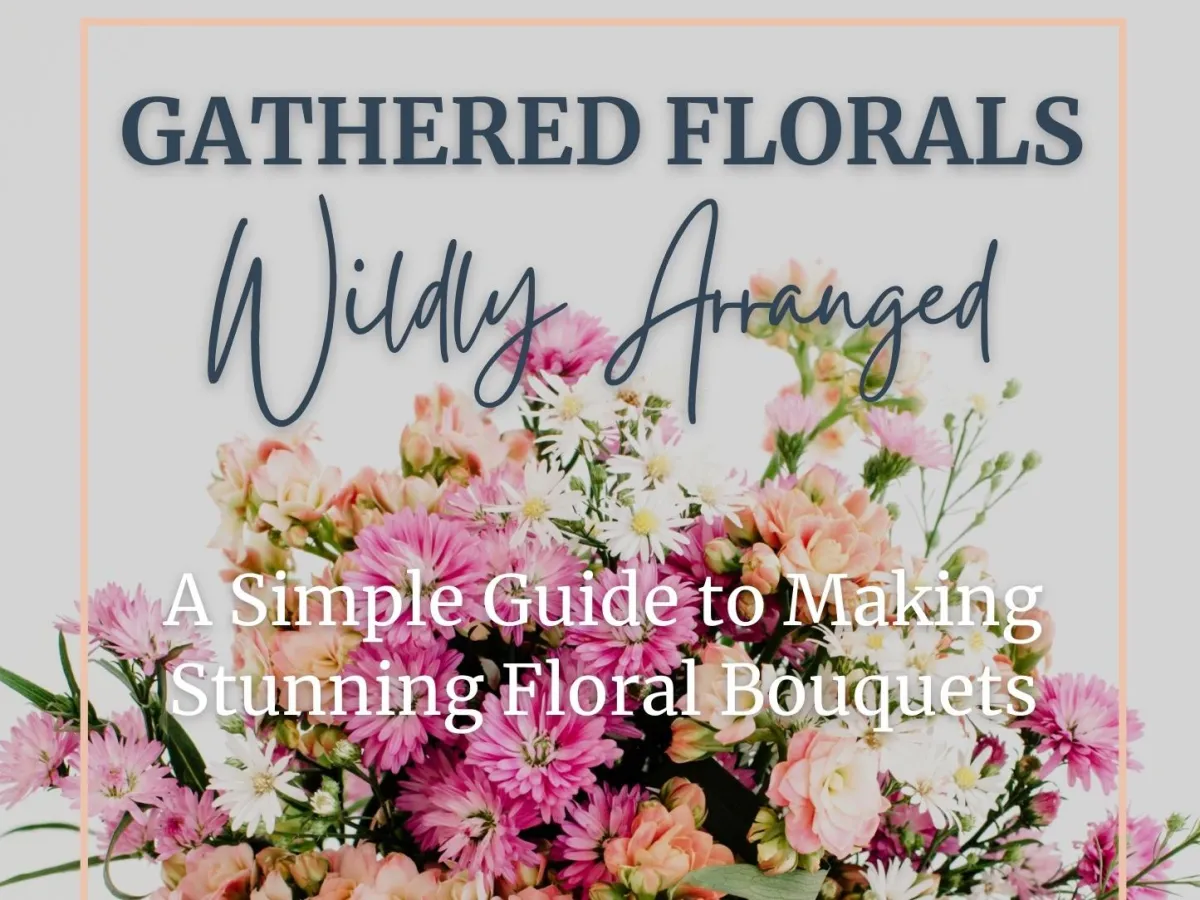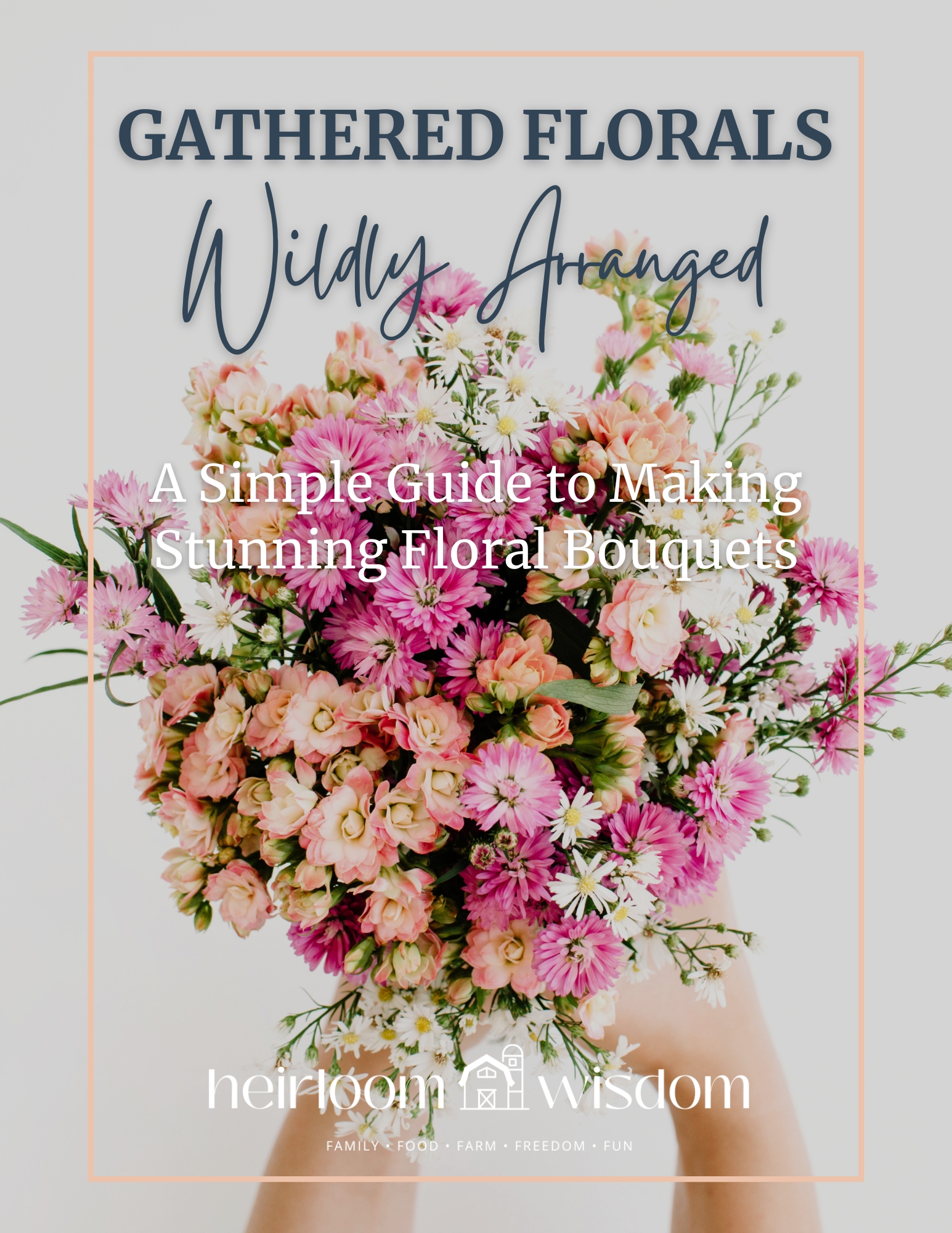
Gathered Flowers: Bouquet Guide
Gathered Flowers: A Simple Guide to Making Stunning Floral Bouquets
This guide covers everything from choosing the best flowers and greenery to arrangement and display!
Jump to a section:
Choosing and Preparing Your Flowers
Creating a fresh flower bouquet is a simple and rewarding way to bring the beauty of nature indoors or share it with someone special.
To begin, select your flowers and greenery thoughtfully:

#1: Choose Seasonal, Fresh Flowers
Pick a mix of:
Focal Flowers: These are your eye-catchers - e.g. roses, dahlias, peonies
Filler Flowers: Medium blooms to support the stars - e.g. snapdragons, zinnias, cosmos
Textural Accents: Add depth and charm - e.g. herbs, seed heads, grasses
Greenery: Essential for structure and flow - e.g. eucalyptus, mint, ferns
#2: Select a Colour Palette
Stick to 2 to 4 complementary colours to avoid visual clutter.
Soft pastels are perfect for romantic arrangements, while bold contrasts add energy.
More on this in next sections!

#3: Prep the Stems
Strip off leaves below the water line.
Trim stems at a 45-degree angle.
Group flowers loosely by type for easy access during arranging.
Season-Inspired Colour Palettes
Spring

SOFT, FRESH, AND BRIGHT — REFLECTING NEW GROWTH & BLOOMS
Pastel pink, lavender, pale yellow, mint green
Soft peach, baby blue, creamy white, light lilac
Pale coral, buttercup yellow, dusty blue, soft green

Spring Flowers
Pastel pink: Peonies, Ranunculus, Sweet Peas
Lavender: Lavender, Lilac, Verbena
Pale yellow: Daffodils, Tulips, Freesia
Mint green: Dusty Miller, Eucalyptus, Green Hellebore
Soft peach: Garden Roses, Alstroemeria, Carnations
Baby blue: Delphinium, Hydrangea, Cornflower
Creamy white: Gardenias, Lisianthus, Stephanotis
Summer

BOLD, VIBRANT, AND LIVELY — FULL OF ENERGY & SUNSHINE
Sharp, clean knife (like a Hori Hori knife), pruning shears, or shovel
Rooting hormone (optional)
Small pots and well-draining potting mix
Plastic bags or humidity dome
Water spray bottle

Summer Flowers
Hot pink: Zinnias, Geraniums, Dianthus
Sunny yellow: Sunflowers, Marigolds, Black-eyed Susans
Bright orange: Orange Tulips, Tiger Lilies, Calendula
Leaf green: Bells of Ireland, Green Chrysanthemum, Ferns
Scarlet red: Dahlias, Roses, Gerbera Daisies
Cobalt blue: Delphinium, Nigella, Hydrangea
Goldenrod: Solidago, Golden Yarrow
Emerald green: Salal, Ruscus, Ivy
Autumn

WARM, EARTHY,AND RICH—CAPTURING HARVEST & CHANGING LEAVES
Burnt orange, deep burgundy, mustard yellow, olive green
Rust red, golden amber, chocolate brown, forest green
Copper, marigold, cranberry, sage green

Autumn Flowers
Burnt orange: Chrysanthemums, Marigolds, Orange Roses
Deep burgundy: Amaranthus, Celosia, Dahlia
Mustard yellow: Billy Balls (Craspedia), Strawflowers, Rudbeckia
Olive green: Olive branches, Dusty Miller, Lamb’s Ear
Rust red: Celosia, Kangaroo Paw, Red Dahlias
Golden amber: Sunflowers, Autumn Crocus, Chrysanthemums
Chocolate brown: Chocolate Cosmos, Leucadendron
Forest green: Pine, Eucalyptus, Fern
Winter

COOL, ELEGANT, AND CRISP — EVOKING FROST & CALM
Deep plum, icy blue, silver grey, white
Burgundy, evergreen, soft gold, cream
Navy blue, charcoal, frosty mint, pale pink

Winter Flowers
Deep plum: Purple Iris, Calla Lily, Ranunculus
Icy blue: Eryngium (Sea Holly), Delphinium, Blue Thistle
Silver grey: Dusty Miller, Lamb’s Ear, Artemisia
White: White Roses, Baby’s Breath, Anemone
Burgundy: Amaranthus, Wine Red Roses, Carnations
Evergreen: Pine, Cedar, Holly
Soft gold: Goldenrod, Yellow Roses, Mimosa
Cream: Gardenias, White Peonies, Lisianthus
Arranging Your Bouquet
Now that your flowers are prepped, it’s time to build your bouquet.

#1: Start with Greenery
Create the base by placing greenery in your hand first. This provides shape and structure.
#2: Add Focal Flowers
Place your largest blooms one at a time, turning the bouquet as you go to keep balance.
#3: Layer in Fillers and Accents
Add medium and small blooms in between the focal flowers.
Use textured elements to add depth and interest.
Keep the bouquet loose and natural, garden-inspired, not rigid.

#4: Balance and Movement
Stand back and look at your bouquet from all angles.
Adjust as needed so the flowers have visual movement and a natural flow.
#5: Tie and Trim
Secure the stems with twine, raffia, floral wire or tape.
Trim the ends to the same length.
Presentation and Care
Let's get to displaying!

Wrapping for Gift Giving
Wrap your bouquet in kraft paper, linen, or recycled fabric for a rustic, heirloom touch.
Optional: tuck in a handwritten note or tag.

Vase Display
Fill a clean vase with room-temperature water.
Recut stems and arrange your bouquet.
Place out of direct sunlight and change the water every 2 days.
Bouquet Wisdom

Don’t overthink it: Flowers are naturally beautiful. Let them speak for themselves.
Embrace a little wildness: Asymmetry adds charm and movement to your arrangement.
Use what’s in season or from your own garden whenever possible: It adds a personal, local touch and supports nature’s rhythm.
Keep your tools clean: Dirty clippers or vases can shorten the life of your blooms.
Recut stems every few days: This helps flowers absorb water and stay fresher longer.
Refresh water regularly: Change the water every 2 days to prevent bacteria build-up.
Work near a mirror: It can help you view your bouquet from all angles as you go.
Trust your hands: Don’t be afraid to rearrange as you build —your fingers will find the flow.
Take a photo of your finished bouquet: It’s a great way to track your growth and get inspired for future creations.
Happy Gardening!

Download the e-book version of this blog here (or click the image above)!
Get empowered with more Heirloom Wisdom™ education by visiting heirloom-wisdom.com!
